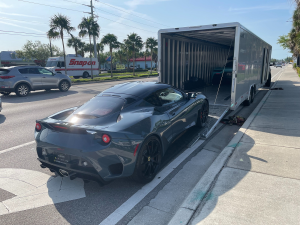How to safely Ship your Classic Car

Shipping a classic car requires special care, attention, and expertise. Unlike regular vehicles, classic cars are valuable, sometimes irreplaceable, and often fragile. Whether you’re relocating, buying, selling, or attending a car show, ensuring your classic car arrives in pristine condition should be your top priority.
This comprehensive guide covers everything you need to know about shipping a classic car, from choosing the right shipping method to preparing your vehicle and selecting a reliable transport company. Follow these steps for a smooth, stress-free experience.

Why Classic Car Shipping Requires Special Handling
Classic car are treasured vehicles for their unique parts, sentimental value, and historical significance. Many of these parts are difficult to replace, hence, protecting the vehicle during transport is critical. Unlike modern cars built for durability, classic cars require extra care to prevent damage from external elements and transit risks.
Key Considerations:
- Fragility: Many classic cars have thin metal bodies, intricate detailing, and vintage paint jobs that can be easily scratched or dented.
- Rarity of Parts: Unlike modern vehicles, where replacement parts are readily available, classic car parts can be scarce and expensive.
- Value Appreciation: Many classic cars increase in value over time, making proper handling crucial for maintaining their worth. Even minor damage can significantly impact their resale value, so ensuring secure transport is a priority.
Choosing the Right Classic Car Shipping Method
When transporting a classic car, selecting the appropriate shipping method is crucial to ensuring safety. The two most common transport options are enclosed auto transport and open auto transport.
- Open Transport: More affordable and widely available, but exposes the car to dust, dirt, and debris. While this method is safe for many vehicles, it is less ideal for classic cars due to the increased risk of exposure to environmental conditions.

- Enclosed Transport: This is the best option for classic cars as it provides full protection from weather, road debris, and potential damage. Enclosed trailers shield the vehicle from the elements, making them ideal for high-value and rare cars. Although this shipping method is more expensive, it ensures maximum security and peace of mind.

Preparing Your Classic Car for Shipping
Proper preparation ensures a smooth shipping process and minimizes the risk of damage. Taking the necessary steps before transport can prevent unforeseen complications.
Steps to Follow:
- Conduct a Thorough Inspection: Take high-resolution photos from multiple angles and document any existing dents, scratches, or imperfections. Taking clear pictures before shipping matters because they will serve as proof of the car’s condition before shipping.
- Remove Personal Items & Loose Accessories: Transport companies do not take responsibility for any personal belongings left in the car.Items left inside may shift during transit, causing damage.
- Secure or Remove Aftermarket Parts: Accessories such as antennas, custom mirrors, or spoilers can get damaged or lost during transport. Securing or removing them reduces risks.
- Check for Fluid Leaks: Fix any leaks before transport to prevent issues for your car and other vehicles on the carrier.
- Reduce Fuel Levels: Keep the gas tank at one-quarter or less to reduce weight and fire hazards. Full tanks add unnecessary weight, which can impact transport costs.
- Charge & Secure the Battery: Ensure the battery is properly secured prevents it from shifting or disconnecting during transit.
- Disable Alarm Systems: Prevents unnecessary disruptions that could occur if the alarm is triggered during transport.
- Close Convertible Tops & Windows: Keeps dust and debris from entering the car. If the car has a soft-top, ensure it is securely fastened to prevent damage from wind pressure.
- Use Protective Covers: Adding an extra layer of security for delicate interiors and fragile exterior parts can help minimize the risk of scratches and other minor damages.
Choosing a Reliable Classic Car Shipping Company
Finding a trustworthy transport company is crucial for ensuring a safe and hassle-free shipping experience. Not all auto transporters specialize in classic cars, so choosing a reputable one is key.
What to Look For:
- Experience with Classic Cars: Not all transporters have experience handling vintage and high-value vehicles. Choose a company with a proven track record in classic car transport.
- Proper Licensing & Insurance: Ensure the company is registered with the FMCSA (Federal Motor Carrier Safety Administration) and provides adequate insurance coverage. Confirm the coverage details and consider additional insurance if necessary.
- Customer Reviews & Testimonials: Checking reviews will help to provide insights into the company’s reliability.
- Transparent Pricing & Quotes: A reputable company provides clear pricing without hidden fees. Get multiple quotes and understand what’s included in the cost.
- Tracking & Customer Support: Real-time tracking allows you to monitor your vehicle’s progress. Choose a company with responsive customer service to address concerns during transport.
Essential Tips for a Smooth Classic Car Shipping Experience
To ensure a hassle-free process:
- Book Early: Last-minute reservations can lead to limited transport options and higher costs.
- Understand Insurance Coverage: Some policies have limitations, so purchasing additional coverage may be beneficial.
- Communicate with the Carrier: Get real-time updates on the vehicle’s status and confirm all details before pickup.
- Perform a Final Inspection Upon Delivery: Compare the car’s condition with pre-shipping photos and report any discrepancies immediately.
- Leave Reviews: Sharing your experience helps future customers make informed decisions.
Conclusion
Shipping a classic car requires careful planning, the right transport method, and a trustworthy shipping company. Enclosed transport, proper vehicle preparation, and working with an experienced carrier ensure your valuable investment arrives safely.
With this guide, you now have the knowledge to navigate the shipping process confidently. Whether you’re moving a cherished family heirloom or transporting a prized show car, thorough preparation and smart decision-making will lead to a successful shipping experience.






Post Comment